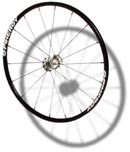Wheelchair Spoked Wheels


These are the large wheels on the back of the wheelchair, exclusive of tires, push rims, and inner tubes. Their appearance is similar to that of bicycle wheels. They include a growing number of spoked performance wheels that are now available for sports and eveyday use.
Performance wheels are used for sports or when increased pushing ease and chair performance are required. The quality of the wheel hub and bearing will affect push-ability and rolling distance. These wheels may have varying numbers of spokes in varying thickness (7 to 10ga), made of varying materials (steel is preferred by purists), and may be laced in a number of ways (interlaced, radial, or crossed). The number and size of the spokes can affect durability, shock absorption, weight, and performance. The more spokes, the more stability the wheel will have. If less spokes are used on the wheel the spokes will have to have greater tension and heavier or stronger rims.
Pros
- Spoked wheels are lighter than molded (Mag) wheels.
- Because they are flexible the spoked wheel will contribute to shock absorption.
- A quality wheel will afford the user a "tighter" performing wheelchair.
- These wheels are often a long term cost saver.
- The most common type of damage is to the spokes and these can be easily replaced without replacing the entire wheel.
- Performance spoked wheels are easier to push, and roll further, saving wear and tear on shoulders.
- Many wheelchair users claim that they prefer these for appearance reasons.
Cons
- May require some additional maintenance.
- Spokes may bend or be damaged on impact.
- Performance wheels are customarily more expensive than everyday spoked wheels.
www.usatechguide.org


